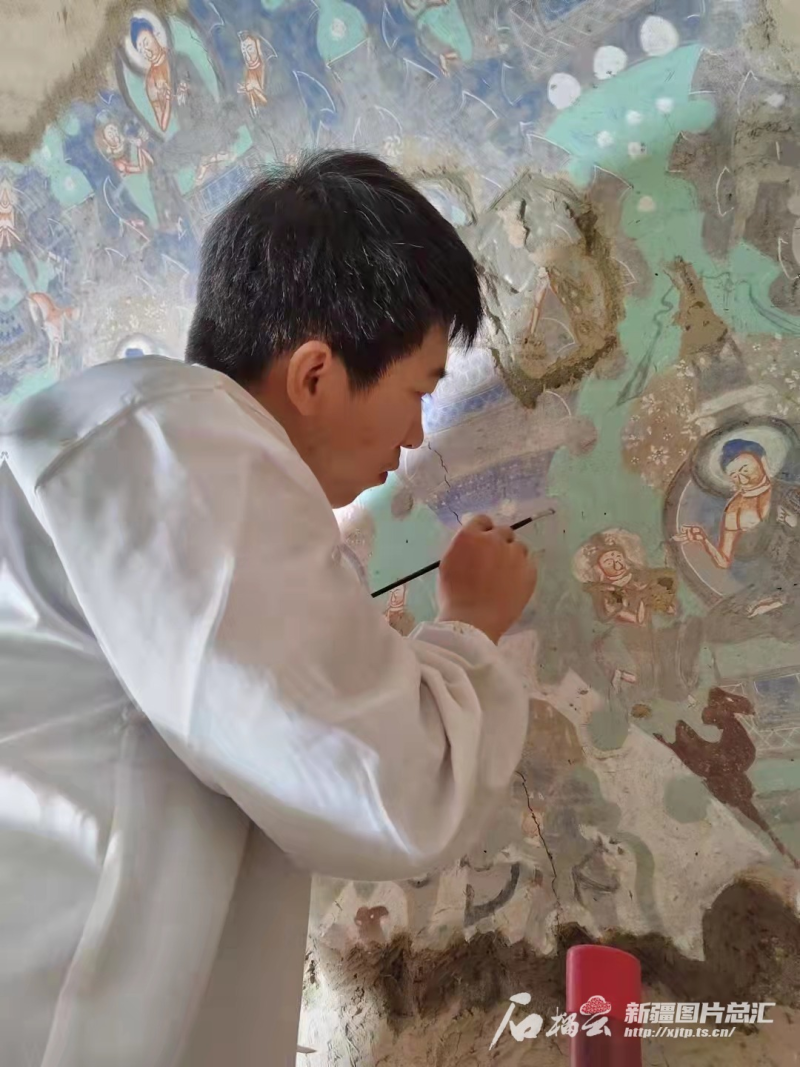Shiliuyun-Xinjiang Daily (Reporter Jia Chunxia) news: The work of mural restoration includes tasks such as cleaning, filling cracks, reinforcement of pigment layers, and microbial control... Upon entering the cave, 37-year-old cultural relic restorer Zhou Zhibo felt like traveling through time. With the same reverence and dedication as the monks and artisans who had worked here a millennium ago, he carried out his work as a "mural doctor."

Photo shows Zhou Zhibo restores murals at the Kizil Caves in Aksu Prfecture, northwest China’s Xinjiang Uygur Autonomous Region. (Photo provided by Zhou Zhibo)
After graduating from Northwest University with a degree in cultural relic protection in 2010, Zhou Zhibo joined the Kizil Caves Research Institute in Xinjiang. Over the past decade, he has participated in the preservation of over 30 caves, restoring more than 130 murals spanning over 100 square meters. Through his work, these ancient masterpieces were restored to their former glory and captivating charm.
According to Zhou Zhibo, compared to other cultural relics, the preservation process for murals is more extensive and complex. Each cave presents unique challenges, and every preservation task comes with its own difficulties. Due to the multi-layered structure of the murals, with each layer having different components and being quite fragile, this means that scientific, detailed surveys, comprehensive testing, and careful operations are necessary throughout the mural protection process.
"Murals can suffer from over 20 common ‘diseases,’ each requiring a unique treatment approach. Just like a doctor treating a patient, we, cultural relic restorers, must first diagnose the cause of the ‘disease’ based on its characteristics, the environmental conditions, and other factors. Once we have a diagnosis, we can develop a targeted treatment plan. After the initial treatment, we also need to implement maintenance measures to prevent recurrence and further deterioration." Zhou Zhibo said, the specific treatment course varies depending on the type of ‘disease’ affecting the mural.
The Kizil Caves are located on a cliff southeast of Mingwutage Mountain, seven kilometers from Kizil Township, Baicheng County, Aksu prefecture, northwest China's Xinjiang Uygur Autonomous Region, and are renowned for their exquisite murals and sculptures. Before coming here, Zhou Zhibo knew very little about the Kizil Caves. The year he graduated, the research institute was recruiting staff, and he and his classmate Yang Jie submitted their resumes together, and were selected to work here.
"I never expected to find such an oasis in the Gobi desert, with so many beautiful murals. Although these murals have existed for thousands of years, they still shine brightly. When I first started the restoration work, I would often find myself lost in these masterpieces." With the idea of doing his best to preserve the murals for a longer time, Zhou Zhibo became a mural restorer.
The most memorable cave that Zhou Zhibo worked on was his very first project, where he joined a team of experts from the Dunhuang Academy to conserve and restore Cave 2 of the Kumutula Grottoes. Under the guidance of his mentor, he selected an area in a corner of the corridor with minor flaking and incomplete paintings.
"Although I had practiced on trial pieces many times before, I still felt nervous when I actually started restoring the murals. The teacher kept reminding me to pay attention to the direction of the needle, control the force, etc." When Zhou Zhibo focused all his attention on restoring the murals, the nervousness in his heart also disappeared. With a sense of awe, he strictly followed the daily training process and carefully completed the mural restoration.
"Under the guidance of excellent teachers, I progressed rapidly. From them, I not only acquired a wealth of knowledge and skills in cultural relics restoration but also witnessed their rigorous approach and unwavering dedication." The guidance of the teachers as well as Zhou Zhibo’s dedication have improved his technical proficiency. He was honored with the third prize in the mural and painted sculpture artifact restoration category at the 2022 national cultural relics industry vocational skills competition.
In recent years, China has prioritized the preservation of its cultural heritage, with an increasing emphasis on technological protection and preventive conservation. Advanced technologies are being utilized to establish comprehensive monitoring and early warning systems for various aspects, including scientific research on the materials and techniques used in cave murals, monitoring environmental changes, and detecting “diseases.” These systems provide valuable data and decision-making support for the research and scientific management of cave preservation.
As time passes, the exquisite murals that embody human wisdom and spirit face the inevitable threat of extinction. What is the significance of a cultural relic restorer? When Zhou Zhibo first embarked on this career, he often pondered this question. Now, with a deeper understanding of mural preservation, he has found the answer, “These murals allow us to engage in a dialogue with our ancestors. It is our duty and responsibility to preserve and pass down these murals so that future generations may also have the privilege of conversing with the past.”
Through his skillful hands, keen eyes, craftsmanship, and enthusiasm, Zhou Zhibo breathes a “second life” into the murals. Promoting the protection and inheritance of China's cultural heritage is where Zhou finds the most fulfillment in his work. “I plan to remain steadfast in Kizil, safeguarding the roots and soul of the millennium-old cultural heritage."
(A written permission shall be obtained for reprinting, excerpting, copying and mirroring of the contents published on this website. Unauthorized aforementioned act shall be deemed an infringement, of which the actor shall be held accountable under the law









